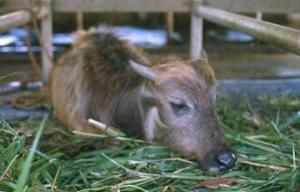Biomarkers of wellbeing & disease in production and companion animals
Published: 17 December 2014
Our research is investigating biomarkers that can be used as a measure of wellbeing and disease in production and companion animals, which are being developed into tests in collaborative work with industry.
Biomarkers of disease in livestock and aquaculture
 All species of animals suffering infection, inflammation or trauma produce acute phase proteins, which are released into the bloodstream. In humans, it is known that measuring the blood concentration of acute phase proteins is a valuable diagnostic test to detect disease and to monitor a patient’s response to treatment.
All species of animals suffering infection, inflammation or trauma produce acute phase proteins, which are released into the bloodstream. In humans, it is known that measuring the blood concentration of acute phase proteins is a valuable diagnostic test to detect disease and to monitor a patient’s response to treatment.
Prior to investigation by Prof. David Eckersall there were no such diagnostic tests for veterinary use. Their research has shown that measuring the concentration of acute phase proteins provides significant diagnostic information for use in animal health assessments. In August 2007, Prof. Eckersall launched ReactivLab Ltd and laid the foundation for commercialising the replication of laboratory methods in assay kits. ReactivLab Ltd was acquired by Avacta Animal Health in 2010, who continue to develop these commercial tests.
Prof Eckersall's research has shown that every species has a differing profile of the protein changes that take place, for example in dogs and pigs (as in man) C-reactive protein can change over 1000 fold within 24 hours of disease onset, while in cows sheep and buffaloes this protein is hardly affected but instead haptoglobin shows a large increase in concentration.
An especially valuable discovery they have made is that the acute phase proteins are synthesised and secreted in milk during bovine mastitis and are biomarkers of this economically important disease of dairy cows. Prof Eckersall's recent work in collaboration with Biomar Ltd and Marine Harvest Ltd, leading companies in aquaculture, has revealed that measuring enolase in the serum of Atlantic salmon is a potential biomarker of infection by salmon alpha-virus.
First published: 17 December 2014
Find out more:
- Institute of Biodiversity, Animal Health and Comparative Medicine
- Glasgow Veterinary Diagnostics Service
- Further work on development of Acute Phase Protein diagnostics in industry
- ReactivLab - Avacta Animal Health
Current staff involved in the research:
- Professor David Eckersall

